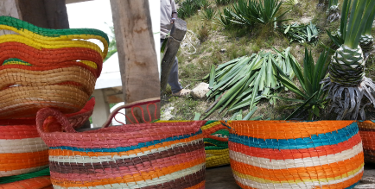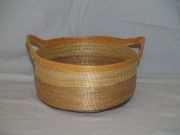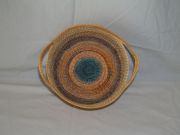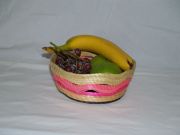
Some of the poorest people on earth sit under a mango tree and use the natural materials available to them to make something beautiful. The could use reeds, grasses, or fiber extracted from a local plant. The folks we are focusing on have developed highly honed skills using the fiber they call "pete." It is a fiber stripped from a type of cactus (agave sisalana). A large plant, it grows taller than six feet and each mature leaf can reach a meter or more in length. Using a dull knife blade embedded in a piece of wood, or a blade with a wooden handle on each end, they scrape the surface of the leaf to remove pulpy green material and expose the fibers that run the full lenght of the leaf. Here is a short video showing this process. Click to play:
When all the pulp is scraped away, the farmers dry the creamy white fibers in the hot Haitian sun and bundle them for sale to artisans or rope makers. After purchasing the dry fiber, the artisans begin to work their magic.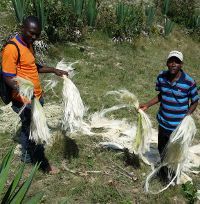
They work in faith believing that someone will see value in their labor. It may take as little as an hour or so to make a Christmas star or several days to finish a larger basket. The work begins with dying the fiber in a hot, boiling vat of dye. Some of you may remember how your mother or grandmother dyed fabric using Ritz Dye. The process is much the same. The freshly dyed fiber is then re-dried in the sun and combed out to yield usable fiber.
With skills passed from worker to worker and generation to generation, they use the fiber to form twisted fiber bundles that are woven into the patterns of a basket. The results can be simple and utilitarian or spectacularly creative. Here are a couple of examples:
Amazingly, all this work is done without any ready outlet for their goods. But they continue in hope. They hope to connect with someone in a local market, some tourist visiting Haiti, or someone browsing the Internet for a unique gift. That is where CPCS comes in. This Haitian cooperative is working hard to bring these crafts to a larger market. That is why this website exists. By clicking on the "Online Store" link in the Main Menu, or by clicking on one of the basket images above, you can enter the store and shop for these lovely handmade sisal items.
The baskets represent hope. These artisans work long and hard hoping to sell their wares so they can feed and educate their children. In a country with nearly 50% unemployment, they have chosen not to sit and do nothing. They have chosen to learn skills, apply those skills, and do their part to earn a living. They have banded together with farmers, bulk sisal merchants, and many others involved in the production of sisal to help find and create markets for the benefit of themselves, their children and others in the cooperative.
What's in a basket? Now let's consider the basket contents. Of course, once a basket is sold, the artisan has nothing more to do with it, but they hope the buyers will proudly use the basket to display fruits and vegetables, or fill it with gifts, or set a lovely plant in it. And they hope that each time the owner of the basket sees it with its contents, they will see a reminder of the contribution they made to help those who are helping themselves. The aritsans hope the owners will talk to others as they offer them an apple or bannana, and tell them about the people of Haiti who are working hard to help themselves. The trade of these baskets can have powerful consequences. Wouldn't you like to buy a powerful basket?

